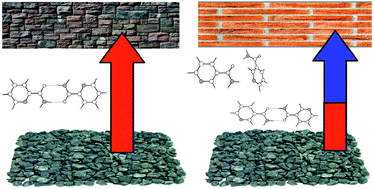Aggregation of nicotinamide (3-pyridine-carboxamide; NA) and picolinamide (2-pyridine-carboxamide; PA) has been investigated by matrix-isolation, supersonic jet and neat solid state infrared spectroscopy, complemented by DFT(B3LYP)/6-311++G(d,p) calculations. For both compounds, the most stable dimeric structure was shown to be the centrosymmetric dimer where two monomers in their most stable forms establish two NH⋯O![[double bond, length as m-dash]](https://www.rsc.org/images/entities/char_e001.gif) C hydrogen bonds. The most stable structures of monomers of NA and PA were characterized in detail experimentally by matrix-isolation spectroscopy and theoretically (at both the DFT(B3LYP)/6-311++G(d,p) and MP2/6-311++G(d,p) levels). For nicotinamide, two conformers were found in the matrices, with ca. 80% of the total population adopting the E form. The monomers and dimers of PA and NA were also investigated by infrared spectroscopy of the studied compounds seeded in supersonic jet expansions. These studies revealed that the constraints on the vibrational dynamics in the PA dimer are different from those in the NA dimer. In the PA dimer, the vibrational energy flow out of the N–H stretching mode was shown to be accelerated substantially by the presence of a secondary intramolecular hydrogen bond. In the glassy state of both compounds, the centrosymmetric dimer seems to be the prevalent structure. In the neat crystalline state (KBr pellet), picolinamide keeps this type of dimeric structure as the constituting unit, whereas nicotinamide molecules assume a different arrangement where one of the NH⋯O
C hydrogen bonds. The most stable structures of monomers of NA and PA were characterized in detail experimentally by matrix-isolation spectroscopy and theoretically (at both the DFT(B3LYP)/6-311++G(d,p) and MP2/6-311++G(d,p) levels). For nicotinamide, two conformers were found in the matrices, with ca. 80% of the total population adopting the E form. The monomers and dimers of PA and NA were also investigated by infrared spectroscopy of the studied compounds seeded in supersonic jet expansions. These studies revealed that the constraints on the vibrational dynamics in the PA dimer are different from those in the NA dimer. In the PA dimer, the vibrational energy flow out of the N–H stretching mode was shown to be accelerated substantially by the presence of a secondary intramolecular hydrogen bond. In the glassy state of both compounds, the centrosymmetric dimer seems to be the prevalent structure. In the neat crystalline state (KBr pellet), picolinamide keeps this type of dimeric structure as the constituting unit, whereas nicotinamide molecules assume a different arrangement where one of the NH⋯O![[double bond, length as m-dash]](https://www.rsc.org/images/entities/char_e001.gif) C bonds is replaced by an NH⋯N(ring) bond. The different crystallograpic structures which were formed by the compounds are reflected in the vibrational spectra of the solids. These observations are correlated with the molecular properties of NA and PA, in particular with the greater conformational mobility of NA compared with PA. This is ascribable to the absence in the NA molecule of the intramolecular NH⋯N(ring) interaction, which exists in PA.
C bonds is replaced by an NH⋯N(ring) bond. The different crystallograpic structures which were formed by the compounds are reflected in the vibrational spectra of the solids. These observations are correlated with the molecular properties of NA and PA, in particular with the greater conformational mobility of NA compared with PA. This is ascribable to the absence in the NA molecule of the intramolecular NH⋯N(ring) interaction, which exists in PA.

You have access to this article
 Please wait while we load your content...
Something went wrong. Try again?
Please wait while we load your content...
Something went wrong. Try again?
![[double bond, length as m-dash]](https://www.rsc.org/images/entities/char_e001.gif) C hydrogen bonds. The most stable structures of monomers of NA and PA were characterized in detail experimentally by matrix-isolation
C hydrogen bonds. The most stable structures of monomers of NA and PA were characterized in detail experimentally by matrix-isolation ![[double bond, length as m-dash]](https://www.rsc.org/images/entities/char_e001.gif) C bonds is replaced by an NH⋯N(ring) bond. The different crystallograpic structures which were formed by the compounds are reflected in the vibrational spectra of the solids. These observations are correlated with the molecular properties of NA and PA, in particular with the greater conformational mobility of NA compared with PA. This is ascribable to the absence in the NA molecule of the intramolecular NH⋯N(ring) interaction, which exists in PA.
C bonds is replaced by an NH⋯N(ring) bond. The different crystallograpic structures which were formed by the compounds are reflected in the vibrational spectra of the solids. These observations are correlated with the molecular properties of NA and PA, in particular with the greater conformational mobility of NA compared with PA. This is ascribable to the absence in the NA molecule of the intramolecular NH⋯N(ring) interaction, which exists in PA.

 Please wait while we load your content...
Please wait while we load your content...